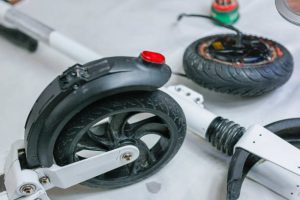As we plunge into the heart of winter, the snow-covered streets and parks offer scooter enthusiasts a unique and exhilarating challenge. We understand the thrill of gliding through a winter wonderland and the joy a snowy ride can bring. However, we’re also acutely aware of the risks associated with scootering in snowy conditions.

That’s why at FamilyHype, we’ve put together this guide on how to ride a scooter safely during winter. We’ll provide tips on choosing the right scooter, the essential gear you’ll need, and how to prepare your scooter for the frosty weather. We’ll also share some proven riding techniques, what to do in case of an accident, and how to maintain and care for your scooter in winter.
Whether you’re an experienced rider or a beginner, we’re here to ensure your winter rides are fun and safe. So, let’s embrace the season, but let’s also remember that safety comes first. And don’t forget to share your opinion and experience with us – we’d love to hear it!
From electric scooters with warm battery technology designed to tackle cold weather to reflective clothing and helmets, having the right scooter gear is essential for a safe winter ride on icy roads, especially when there’s a chance of encountering water.
Key Takeaways
- Choosing the right scooter with a deeper tread for better grip is important.
- Essential gear includes winter clothing, visibility enhancements, and LED lights.
- Snow tires provide better traction, handling, and braking on icy roads.
- Regular maintenance and care of scooters during winter is important.
Understanding The Risks
You’ve got to know zipping around on your scooter in the snow isn’t all fun and games; there are real risks that you need to understand. As we engage in a risk assessment, it becomes clear that the snowfall impact can drastically affect its performance and safety.
The slick, icy streets can make your two-wheeler skid, possibly leading to accidents. Poor visibility during heavy snowfall can also make riding in winter less noticeable to drivers, which increases the risk of collisions when you ride an electric scooter in the winter.
To ensure your safety and extend your scooter battery life during winter riding, it’s crucial to adjust your riding style and pay extra care to safety equipment and winter riding. Electric scooter riders must take extra care in winter conditions when riding in winter.

We’re not saying this to scare you but to ensure you’re aware and prepared for these challenges.
Being mindful of these risks, let’s move forward with compassion and empathy for others, ensuring we ride safely.
Next, let’s delve into the importance of choosing the right scooter for these conditions.
Choosing The Right Scooter
Picking the perfect set of wheels for icy conditions isn’t just about style; it’s crucial for ensuring smooth and secure journeys. We’re talking about scooter customization that can make all the difference.
- Consider the tread: You need tires with deeper treads for better grip.
- It’s about your safety and that of others around you.
- Imagine slipping and causing an unnecessary accident.
- Look for winterproof accessories.
- They’re designed to withstand icy conditions, ensuring your safety and those you serve.
- Think how content you’ll feel knowing you’ve taken every precaution.
Choosing the right scooter can be a lifesaver during winter months. Next, we’ll explore essential gear that further enhances your winter scootering experience.
Essential Gear For Winter Riding
Navigating icy streets is no small feat, but with the right gear, it’s a breeze. We can’t stress enough the importance of being well-equipped.
Winter clothing is, of course, a must-have. Layering up is essential to keep warm, but remember to ensure flexibility and comfort in movement too. Water-resistant jackets, thermal gloves, and insulated boots are our top picks.
Visibility enhancements also play a pivotal role in winter scootering. Shorter days mean less natural light, making it harder for drivers to spot us. High-visibility vests or reflective strips on our clothing can make all the difference. Additionally, consider using LED lights on your two-wheeler for added safety.
Now that we’re all geared up, it’s time to get our scooters winter-ready.
Preparing Your Scooter
Before we hit the icy roads, we’ve got to double-check some things on our scooters.
We can’t stress enough the importance of checking tire pressure – it’s crucial to maintaining traction and avoiding slippery situations.
Additionally, we must ensure they are properly lubricated to prevent parts from freezing and ensure a smooth, safe ride.
Checking Tire Pressure
Don’t overlook the importance of checking your scooter’s tire pressure before hitting the snowy trails! Pressure variations can drastically affect your ride’s safety and performance. Ensuring proper tire inflation is a key step to preventing accidents.
Here are some pointers to remember:
- Always check your tire pressure when the tires are cold.
- Follow the manufacturer’s recommended tire pressure.
- Use a reliable tire pressure gauge.
- Regularly inspect tires for any signs of wear or damage.
- Remember, lower tire pressure can increase traction on slippery surfaces.
We can’t stress enough how crucial this process is. The right tire pressure can greatly affect your safety and comfort.
Now that we’ve covered tire pressure, let’s move on to another vital part of upkeep – ensuring your it is properly lubricated.
Ensuring Proper Lubrication
You’ll feel like a pro mechanic after properly lubricating your ride, and trust us, your two-wheeled companion will thank you for it. Lubrication helps reduce friction, allowing parts to move smoothly while preventing wear and tear. It’s a simple act of service that keeps your scooter running efficiently, especially in harsh winter conditions.
There are various lubrication types to consider, including greases and oils. Each has its benefits and is suitable for different parts of your scooter. The key is to identify which type works best for your specific ride.
Lubrication frequency is another vital aspect. We recommend lubricating your scooter after every 100 miles of use or every month, whichever comes first. However, during winter, the frequency may need to increase.
Riding Techniques During Winter
Now, let’s delve into the crux of riding your scooter in snowy conditions: maintaining balance and handling slippery surfaces.
We understand these aspects can seem challenging, particularly if you’re not accustomed to winter rides. However, with the right techniques and a dose of caution, we can assure you that you’ll be able to navigate the snowy streets safely and confidently.
Maintaining Balance
Maintaining balance on a scooter while gliding over a snowy path might seem like a precarious dance, but it’s achievable with the right techniques and precautions.
We want to keep you safe, so we share the best ways to maintain balance amidst obstacles. Adjusting your stance is key. Rider flexibility plays a crucial role in maintaining stability. Keep your knees slightly bent and your body relaxed. This allows for easier navigation and the ability to adjust quickly to sudden changes in the terrain.

Remember, your safety is paramount. We understand the thrill of a winter ride, but caution is essential.
Now that we’ve tackled balance let’s discuss how to handle the ever-challenging, slippery surfaces winter presents.
Handling Slippery Surfaces
Having discussed the importance of maintaining balance while scootering in snow, let’s delve into the challenging aspect of handling slippery surfaces.
Understanding that the usual tires won’t suffice in winter conditions is essential. That’s where snow tires come into play. The benefits of snow tires are significant as they provide better traction, handling, and braking on icy roads. They are designed with special tread patterns and rubber compounds to handle low temperatures and snowy conditions.
Additionally, it’s crucial to master ice navigation strategies. Slow down when you spot ice, and keep your scooter straight to avoid skidding. Remember, safety comes first!
As we continue to explore the thrills of winter scootering, let’s next consider the specific rules for scootering in snow.
Rules For Scootering In Snow
When you’re gliding through a winter wonderland on your scooter, following certain rules to ensure your ride is safe and enjoyable is essential. This isn’t just about you; it’s about serving the community by maintaining a safe environment for all.
- Snow Visibility: Always wear bright colors to enhance your visibility in the snow. Consider adding reflective tape on your scooter too.
- Frostbite Prevention: Wear insulated gloves and warm footwear to prevent frostbite.
- Path Clearing: Always clear your path of snow and ice before scootering.
- Speed Control: Maintain a slower speed to avoid accidents on slippery surfaces.
By respecting these rules, we can all enjoy scootering in the snow. Now, let’s discuss how to handle unexpected situations like accidents.
What To Do In Case of An Accident
While we’ve guided you through the rules for scootering in winter, it’s equally crucial to be prepared for unexpected mishaps. In unfortunate situations where an accident occurs, your immediate response is pivotal.
First and foremost, ensure the safety of all involved. Afterward, accident documentation becomes a priority. It’s important to take detailed notes of what happened, snap photos, and gather witnesses’ contact information if possible. This can significantly assist in any potential insurance claims.
Remember, your well-being is paramount; seek immediate medical attention even if injuries appear minor initially. Lastly, don’t forget to promptly report the accident to your insurance provider.
As we progress, we will focus on regular maintenance and care of your scooter during the frosty winter months.
Maintenance And Care Of Your Scooter In Winter
As we navigate through the fun and challenges of winter scooter riding, we must also focus on the regular cleaning, inspection, and appropriate storage of our scooters.
Let’s not underestimate the importance of these routines, as they are crucial in prolonging the life of our scooters, ensuring safety, and maintaining optimal performance during the chilling winter months.
Remember, a little care and caution can go a long way in keeping our rides smooth and our scooters in great shape.
Regular Cleaning And Inspection
You’d be surprised how much regular cleaning and inspection can enhance your scooter’s performance and safety during winter rides. We’re not just talking about aesthetics here; each component of your scooter, from the brakes to the handlebars, benefits from routine care.
A proper cleaning schedule removes dirt, grime, and salt that can cause corrosion over time. This is especially crucial for brake maintenance, as effective brakes are your lifeline when maneuvering on slippery surfaces. You can use a mild soap solution for scooter sanitization, ensuring cleanliness and the health of whoever uses it.
Storing your scooter properly is essential when you’ve given every part a good scrub and inspection. Let’s delve into some handy storage tips in the next section.
Storage Tips
Proper storage is crucial to maintain your ride’s performance and longevity, particularly during those frosty months. We need to prepare our scooters for the winter, and we have some straightforward tips to help you out:
- Firstly, keep an eye on your scooter’s battery. Battery care is essential, especially in cold temperatures. We recommend storing it in a room-temperature environment to avoid any damage.
- Secondly, ensure your scooter isn’t exposed to moisture. Apply anti-rust measures to keep it from aging prematurely.
- Lastly, always store your scooter indoors. This guards it against harsh weather conditions and extends its lifespan.
Remember, a little precaution goes a long way.
Next, we’ll delve into why it’s beneficial to consider taking a scooter safety course.
Taking A Scooter Safety Course
Enrolling in a scooter safety course can provide valuable insights and training, helping you navigate the tricky winter weather with confidence and precision. It’s not just about learning to balance on two wheels; it’s about understanding the dynamics of snow, ice, and cold temperatures on your scooter’s performance.
A course certification could be a game-changer for you, especially during winter. This adult training is designed to equip you with the know-how to ride safely, even in less-than-ideal conditions. It’ll arm you with the knowledge of when it’s safe to ride and when it’s prudent to leave the scooter at home.
As we go through this journey together, remember that your safety is paramount. This brings us to the next crucial consideration – recognizing when conditions are too perilous to ride.
Knowing When Not To Ride
It’s critical to understand that there will be times when Mother Nature doesn’t permit a smooth, uneventful journey on your two wheels. Weather considerations play a huge part in knowing when not to ride.
Snowfall can make the pavement slippery, and the cold can make your scooter’s components behave unpredictably. Visibility challenges are another factor to consider. Snow and ice can obscure road markings and make other road users less visible.

We want you to enjoy your scooter ride, but we also want you to be safe. It’s better to wait for a clear day than to risk an accident in poor conditions. Remember, we’re in this together, and our ultimate goal is to ensure that every ride is fun and safe.
Conclusion
We’ve covered a lot in this guide, haven’t we? From choosing the right scooter to learning how to ride safely during winter, it’s clear that winter scootering can be both fun and safe.
If you’ve had a good experience, we’d love to hear about it on FamilyHype! We’re here to help others find and keep the best scooters safe. That’s why it’s important to consider the weather, terrain, and skill level when selecting the right scooter for you. Don’t forget to pay attention to the battery life, brakes, and details like the size and weight of the scooter.
Always remember to prioritize your safety. If conditions are too harsh, it’s okay not to ride. Remember, we’re here to enjoy the ride and make it home safely.
Stay warm, stay safe, and happy scootering!
Frequently Asked Questions
Can I ride a scooter in the snow?
Riding an electric scooter in the snow is not recommended. Snowy conditions can make the roads slippery and reduce traction, making riding unsafe. It’s best to avoid riding them in winter for your safety.
Can I use a scooter in winter?
While some scooters may be able to handle light winter conditions, it is generally advised to avoid using them in winter. Extreme weather conditions like heavy snow and icy roads can pose significant rider risks. It’s better to prioritize safety and wait for more favorable riding conditions.
How cold is too cold for a scooter?
Electric scooters are generally designed to operate within a specific temperature range. Extreme cold temperatures can affect the battery’s performance and may even cause it to fail. Generally, it is best to avoid riding an electric scooty when the temperature falls below freezing or is too cold to ride comfortably.
Does cold weather affect the scooter?
If you’re planning to ride an electric scooter, it’s important to consider its battery and keep a few tips in mind. Cold weather can have an impact on electric them, especially the battery. The battery’s capacity may decrease in colder temperatures, resulting in a shorter riding range. Additionally, cold weather can make the their tires less grippy, potentially affecting traction. Being aware of these factors when riding in cold weather is important.
How do I prepare my scooter for winter?
To prepare your scooter for winter, storing it in a dry and sheltered place, away from extreme cold or moisture, is recommended. It’s also a good idea to fully charge the battery before storing it. If you plan to continue riding in winter, consider installing tires with better traction and using appropriate winter gear.
Riding an electric scooter in winter requires extra attention to its battery and potential hazards. The battery may experience reduced performance due to cold temperatures, affecting the overall range and power. To mitigate this, it’s advisable to keep the battery charged and avoid riding in extremely cold weather.
Be mindful of wet conditions, as snow and slush can create slippery surfaces. Ride steady and maintain a safe distance from other vehicles or pedestrians. Prioritize winter safety by protecting yourself from head injuries with a helmet and avoiding deep water or snow, which can cause instability and damage to your e-scooter.
How can I protect my scooty from winter?
To protect your electric scooter during winter, clean it regularly to prevent the build-up of dirt, salt, or other corrosive substances. Apply a protective coating on metal parts to minimize the risk of rust. Additionally, store your two-wheeler in a dry and secure location to avoid extreme cold and moisture exposure.
What are some essential tips for riding a scooter safely and enjoyably in winter?
There are a few essential tips to ensure a safe and enjoyable experience with your two-wheeler in the winter. Firstly, ensure it has air-filled or specialized winter tires to improve traction on icy or icy surfaces.
Wear cycling glasses to protect your eyes from wind, snow, and debris. Properly grip the handlebars to maintain control, even on uneven or slippery terrain. Before starting your ride, slowly warm up the scooter’s motor for optimal performance.
Lastly, remember that winter riding conditions can be unpredictable, so if the weather becomes severe or you encounter deep snow, it’s best to stop riding and seek shelter until conditions improve.
What safety measures should I take when riding an electric scooter in winter?
When riding an electric scooter in winter, it’s crucial to prioritize safety and adapt to challenging conditions. Adjust your riding style to accommodate the slippery surfaces, and ride cautiously. Additionally, ensure you have the appropriate safety equipment, including a helmet, knee and elbow pads, and sturdy footwear.
Most of them are not designed for extreme winter conditions, so it’s important to be cautious. If your scooter has an anti-lock braking system (ABS), use it to maintain control during sudden stops or when encountering icy patches. Remember to wear reflective clothing to enhance visibility, especially in low-light or wet areas.
Is it safe to lock the scooter outside?
It’s generally not recommended to leave your scooter locked outside for an extended period, especially in winter. Exposure to harsh weather conditions, including snow and moisture, can potentially damage the electrical components and reduce its lifespan. It’s safer to store it indoors when not in use.
Leaving your two-wheeler locked outside also increases the risk of theft or vandalism. Even with a sturdy lock, determined thieves may still attempt to steal or damage it. If you must leave it outside briefly, consider finding a well-lit and secure area or using multiple locks to deter potential thieves. However, storing it indoors or in a secure storage facility for extended periods or in areas with higher crime rates is best to ensure its safety and longevity. Taking these precautions will help protect your investment and ensure your scooter remains in good condition for years.
Can scooters be easily stolen?
The ease of stealing a scooter can depend on several factors, including the type and security measures in place. Generally, traditional kick scooters are less likely to be stolen due to their lightweight and foldable design, which makes them easier to carry and store when not in use. However, electric scooters (e-scooters) are more valuable and can be targeted by thieves if left unattended.
Some shared e-scooter rental programs have implemented GPS tracking and built-in locks, making it harder for thieves to steal them without detection. Additionally, owners can use anti-theft devices such as locks, alarms, and even GPS trackers to protect them from theft.
Ultimately, while it is possible for scooters to be stolen, taking preventive measures can significantly reduce the risk of theft. It’s essential to secure it properly, avoid leaving it unattended in vulnerable areas, and use additional security features to deter potential thieves.
DISCLAIMER (IMPORTANT): This information (including all text, images, audio, or other formats on FamilyHype.com) is not intended to be a substitute for informed professional advice, diagnosis, endorsement or treatment. You should not take any action or avoid taking action without consulting a qualified professional. Always seek the advice of your physician or other qualified health provider with any questions about medical conditions. Do not disregard professional medical advice or delay seeking advice or treatment because of something you have read here a FamilyHype.com.
